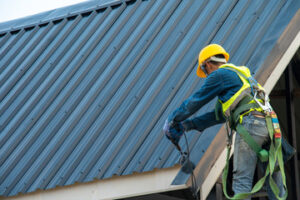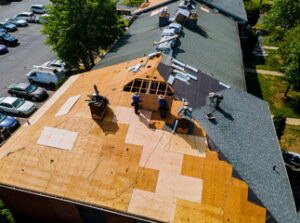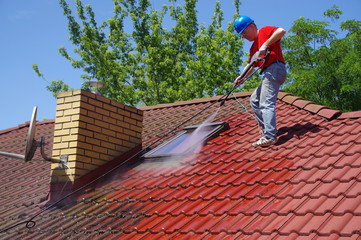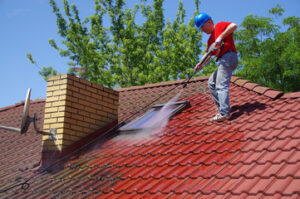Roof maintenance is an important part of preventing costly damage to buildings and property. Whether you notice water stains on ceilings, a sagging roof or cracked shingles, addressing problems promptly can save you thousands of dollars in repair bills.

A good maintenance plan includes seasonal inspections. Cleaning gutters and downspouts helps prevent clogs, while trimming nearby trees keeps debris from damaging the roof. Visit https://www.fivestarroofingandcontracting.com/metal-roofing-jenks-oklahoma for more information.
As the first line of defense, shingles are important to a roof’s overall health. Cracked, curling, buckling, or missing shingles not only don’t look great, but they can allow water to seep in and damage your home. This is why it’s critical to inspect your shingles regularly. A good place to start is with a visual inspection.
Begin by climbing onto the roof and looking for any shingle damage. Shingles that are curled, cracked, or blistered need to be replaced as soon as possible. These damaged shingles are weak points that can lead to leaks and rot in the wood framing underneath. In addition, any shingle that is missing should be immediately replaced to prevent moisture infiltration.
If you find any shingle granules in the gutters or scattered throughout your yard, this is another sign that it’s time for an inspection and replacement. The loss of granules exposes the underlying material to more damage, and it’s also an indication that your shingles are approaching their expected lifespan. Pay particular attention to areas around vent pipes and other protrusions on the roof, as they are more susceptible to damage from debris and hail.
On asphalt shingle roofs, it’s also a good idea to check for any bare spots or gaps in the shingles. These bare spots should be cleaned and then patched with roofing cement. This will prevent further water infiltration and help extend the life of your shingles.
Finally, you should also check for any moss or algae growth on the roof. Algae can rot the underlying wood and can also cause leaks. The wet climate in the Mid-Atlantic region makes it particularly easy for moss and algae to grow on shingles, so regular cleaning and inspection is crucial.
If you’re uncomfortable or unsafe climbing on your roof, it is a good idea to hire a professional roofing contractor like Gunner to conduct a thorough inspection of your shingles and other components of your roof. A professional can identify issues that you may have missed and recommend the best course of action to ensure your roof stays healthy and in good repair.
Check the Gutters
As part of the roofing system, gutters collect and carry runoff from the roof surface. They are essential for keeping the roof free of water and preventing damage to the building structure. Clogged gutters can cause water to overflow, resulting in roof rot and structural damage. Water also pools in and around the foundation, causing problems such as cracked concrete and damp walls. Gutters also minimize soil erosion around the foundation, reducing the risk of settling and foundation damage.
Regular inspections of the gutter system can help identify potential problems. During the inspection, a professional will check for rust, sagging, and other signs of wear and tear. They will also examine the downspouts and ensure they are securely attached to the gutters and that they drain properly. They will also inspect the sealant and caulking around the gutter seams, joints, and end caps for deterioration or gaps that may lead to water leakage.
The inspector will also look for clogged gutters, downspouts, and drains, as well as obstructed or overflowing outlets. They will test the drainage capacity of the gutters by pouring water into them to ensure they are functioning properly. They will also assess the alignment and pitch of the gutters, ensuring they slope properly toward the downspouts to facilitate drainage.
Gutters should be pitched at an angle of about 1/16 inch per foot, or 1/4 inch per 5 to 10 feet. Any greater of an angle will not promote effective drainage. If gutters are obstructed by leaves, twigs, or other debris, they should be cleaned regularly. The gutters should also be free of any ice dams or snow accumulation that can inhibit the flow of water and cause back-up.
A regular roof maintenance program can catch most major issues, avoiding costly repairs and extending the life of your roof. While a DIY roof inspection can help spot the most obvious issues, it’s important to have a professional inspection at least twice each year. This will ensure any problems are caught early, minimizing the impact they can have on your home’s safety and comfort.
Check the Flashing
The flashing is a vital part of your roof, as it seals the gap between the shingles and other parts of the roof. This includes the areas around chimneys, vent pipes, openings and windows, skylights, and other structures. When the flashing becomes damaged, it leaves your home vulnerable to leaks and water damage. Fortunately, fixing the flashing is relatively simple.
A quick visual inspection of the flashing can help you identify the problem and make the necessary repairs. Look for the following signs of trouble:
Rust or Corrosion
Metal flashing is susceptible to rust and corrosion, especially if it is exposed to the elements over an extended period of time. Inspect the flashing for rust or corrosion to prevent water infiltration.
Loose or Missing Flashing
Storm damage, age, and shoddy installation can cause the flashing to become loose or dislodged from the roof. Inspect the flashing for holes or gaps to ensure a tight seal and prevent water penetration.
Cracks or Gaps
Even small cracks or gaps in the flashing can allow water to seep into your home, causing significant problems. Leaks from the flashing are most common around chimneys and other vents, but they can occur anywhere on your roof.
Poor Sealant
A poorly-applied caulk or roof sealant can deteriorate over time and leave your flashing vulnerable to leaks. It is essential to use high-quality roof sealants for your roof maintenance and repair projects.
Extensive or Significant Damage
When the flashing is heavily corroded, missing, or visibly damaged, it is time to call in a professional. These types of issues can lead to major and expensive repairs, including water damage to the roof deck, insulation, and interior of your home.
Performing regular roof maintenance can help you spot potential flashing problems and address them before they become serious. In addition to preventing leaks, these steps can extend the lifespan of your roofing system and keep your home safe and healthy for years to come.
Check the Trees
A healthy tree adds value to a property and offers protection from the elements. But trees can shift from assets to liabilities when they become damaged or fall onto homes, buildings, cars, pedestrians, and other structures. Regular inspections can help identify and address potential hazards to ensure the safety of people, cars, and other properties.
In addition to the obvious, like missing shingles and minor leaks, it is important to check the condition of the roof’s support structure. Damage to the supports can lead to serious problems with the roof, such as water leaks and structural issues. It is also important to check the condition of nearby trees. Large branches that hang over a house or other structure can damage the roofing materials, as well as cause injuries and property damage during storms. Regularly trimming these branches can prevent this kind of damage.
Examine the Roots
Look for mushrooms, cracks, splits, and fungi along the base of the trunk to determine how stable the tree is. These signs of rot and weakness could indicate that the tree needs to be removed.
Check the Canopy
Look for dangling branches and branches caught in the canopy that could fall during a storm. These are called “widow makers” and can be dangerous for homes, parked vehicles, and other structures.
Check for Major Damage
Every tree drops some small branches and twigs during a storm, but if you see a lot of these or notice that the number is increasing, it could be an indicator that the tree is dying. Look for cracks in the trunk, vertical cracks in the roots, and cankers (dead sections of bark).
Inspecting a roof and the surrounding landscape on a regular basis can prevent small problems from becoming serious ones. It can also save you the cost of a complete roof replacement or expensive repairs caused by tree debris and other conditions beyond your control. Contact a professional roofer if you have questions about the inspection process or identifying potential problems. They can provide a detailed report and recommended solutions.



